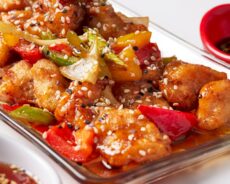Thai cuisine is known for its bold flavors, aromatic herbs, and vibrant colors. It is a unique and diverse culinary tradition that has been influenced by neighboring countries such as China, India, and Malaysia. The history of Thai cuisine dates back centuries, with its roots in the ancient kingdom of Sukhothai. Over time, Thai cuisine has evolved and developed into the rich and flavorful cuisine that it is today.
Food holds a special place in Thai culture, as it is not only a means of sustenance but also a way to bring people together. In Thailand, meals are often shared with family and friends, and the act of eating is seen as a social event. Thai people take great pride in their food and are known for their hospitality and generosity when it comes to sharing meals with others.
The Unique Flavor Profile of Thai Food
One of the defining characteristics of Thai cuisine is its unique flavor profile. Thai dishes are known for their balance of sweet, sour, salty, and spicy flavors. This combination of flavors creates a harmonious taste experience that is both complex and satisfying.
In addition to the four main flavors, Thai cuisine also incorporates the fifth taste sensation known as umami. Umami is a savory taste that is often described as meaty or brothy. It adds depth and richness to dishes and can be found in ingredients such as fish sauce, shrimp paste, and fermented soybean products.
Some popular examples of Thai dishes with unique flavor profiles include Pad Thai, a stir-fried noodle dish that combines sweet, sour, and salty flavors; Tom Yum Soup, a hot and sour soup that balances spicy, sour, and savory flavors; and Green Curry, a spicy curry made with green chilies, coconut milk, and fragrant herbs.
The Role of Spices and Herbs in Thai Cooking
Spices and herbs play a crucial role in Thai cooking, adding depth of flavor and aroma to dishes. Some commonly used spices in Thai cuisine include chili powder, turmeric, coriander, cumin, and cardamom. These spices are often used in curry pastes and marinades to add heat and complexity to dishes.
Herbs are also an essential component of Thai cuisine. Some commonly used herbs include lemongrass, kaffir lime leaves, Thai basil, cilantro, and mint. These herbs add freshness and brightness to dishes and are often used in soups, salads, and stir-fries.
In addition to their flavor-enhancing properties, many Thai spices and herbs also have health benefits. For example, turmeric is known for its anti-inflammatory properties, while lemongrass has been used in traditional medicine to aid digestion and relieve stress.
Popular Thai Dishes You Must Try
| Dish Name | Ingredients | Spiciness Level | Region |
|---|---|---|---|
| Pad Thai | Rice noodles, shrimp, tofu, bean sprouts, peanuts, egg, tamarind sauce | Mild | Central Thailand |
| Tom Yum Goong | Shrimp, lemongrass, galangal, kaffir lime leaves, chili, lime juice | Spicy | Central and Southern Thailand |
| Green Curry | Chicken, eggplant, green chili, coconut milk, basil, kaffir lime leaves | Medium | Central Thailand |
| Mango Sticky Rice | Glutinous rice, mango, coconut milk, sugar | Mild | Central and Northern Thailand |
| Massaman Curry | Beef, potatoes, peanuts, coconut milk, tamarind paste, cinnamon, cardamom | Mild | Southern Thailand |
When it comes to Thai cuisine, there are several iconic dishes that you simply must try. These dishes showcase the unique flavors and ingredients of Thai cooking and are beloved by locals and tourists alike.
One such dish is Pad Thai, a stir-fried noodle dish that is often considered the national dish of Thailand. It features rice noodles cooked with eggs, tofu or shrimp, bean sprouts, and a tangy sauce made from tamarind paste, fish sauce, and palm sugar. It is typically garnished with crushed peanuts and a squeeze of lime.
Another must-try dish is Tom Yum Soup, a hot and sour soup that is bursting with flavor. It is made with a fragrant broth flavored with lemongrass, kaffir lime leaves, galangal (a type of ginger), chili peppers, and lime juice. It can be made with shrimp or chicken and is often garnished with fresh cilantro.
Green Curry is another popular Thai dish that you should definitely try. It is a spicy curry made with green chilies, coconut milk, and a variety of herbs and spices. It can be made with chicken, beef, pork, or tofu and is typically served with steamed rice.
Other must-try Thai dishes include Massaman Curry, a rich and flavorful curry made with potatoes, peanuts, and tender chunks of meat; Som Tum (Papaya Salad), a refreshing salad made with shredded green papaya, tomatoes, green beans, and peanuts; and Mango Sticky Rice, a delicious dessert made with sweet sticky rice, ripe mangoes, and coconut milk.
The Art of Thai Street Food
Street food is an integral part of Thai culture and is a must-try for any food lover visiting Thailand. Thai street food is known for its bold flavors, affordability, and convenience. It offers a wide variety of dishes that range from savory to sweet, and can be found in bustling markets, street stalls, and food carts throughout the country.
Some popular Thai street food dishes include Pad Thai (stir-fried noodles), Som Tum (papaya salad), Moo Ping (grilled pork skewers), Gai Yang (grilled chicken), and Khao Niew Mamuang (mango sticky rice). These dishes are often cooked to order right in front of you, ensuring that they are fresh and flavorful.
If you’re looking to experience the best Thai street food, head to cities like Bangkok, Chiang Mai, and Phuket. These cities are known for their vibrant street food scenes and offer a wide variety of dishes to choose from. Whether you’re craving spicy noodles, grilled meats, or sweet treats, you’re sure to find something that satisfies your taste buds.
Regional Variations in Thai Cuisine

While Thai cuisine is known for its bold flavors and aromatic herbs, it is important to note that there are regional variations in Thai cooking. Each region of Thailand has its own unique culinary traditions and specialties, influenced by factors such as geography, climate, and cultural heritage.
In the northern region of Thailand, dishes are often milder in flavor and incorporate ingredients such as ginger, turmeric, and tamarind. Some popular dishes from this region include Khao Soi (curry noodle soup), Sai Oua (northern Thai sausage), and Kaeng Hang Le (pork curry).
In the northeastern region of Thailand, also known as Isaan, dishes are known for their bold and spicy flavors. Sticky rice is a staple in this region and is often served with dishes such as Som Tum (papaya salad), Larb (minced meat salad), and Gai Yang (grilled chicken).
In the southern region of Thailand, dishes are influenced by the flavors of Malaysia and Indonesia. Coconut milk is a common ingredient in southern Thai cuisine, and dishes often feature seafood and spices such as turmeric and cumin. Some popular dishes from this region include Massaman Curry, Gaeng Tai Pla (southern Thai fish curry), and Khao Yam (rice salad).
Thai Food and Its Health Benefits
Thai cuisine is not only delicious but also offers several health benefits. Many Thai dishes are made with fresh ingredients such as herbs, vegetables, and lean proteins, making them a nutritious choice.
One of the key health benefits of Thai cuisine is its use of herbs and spices. Many Thai spices and herbs have been used in traditional medicine for centuries due to their healing properties. For example, turmeric is known for its anti-inflammatory properties, while lemongrass has been used to aid digestion.
Additionally, Thai cuisine often incorporates a variety of vegetables into dishes, providing essential vitamins, minerals, and fiber. Vegetables such as broccoli, bok choy, and bell peppers are commonly used in stir-fries and curries.
When dining out at a Thai restaurant, there are several tips you can follow to make healthier choices. Opt for dishes that are steamed, grilled, or stir-fried instead of deep-fried. Choose dishes that are packed with vegetables and lean proteins such as chicken, fish, or tofu. And be mindful of portion sizes, as Thai dishes can be quite generous.
Vegetarian and Vegan Options in Thai Cuisine
If you’re vegetarian or vegan, you’ll be pleased to know that Thai cuisine offers a wide variety of options to suit your dietary preferences. Many traditional Thai dishes can easily be modified to be vegetarian or vegan by substituting meat or animal products with plant-based alternatives.
Some common vegetarian and vegan Thai dishes include Pad Thai (made with tofu or vegetables instead of meat), Green Curry (made with tofu or vegetables), and Tom Yum Soup (made with mushrooms instead of shrimp or chicken).
In addition to these traditional dishes, there are also several vegetarian and vegan restaurants in Thailand that specialize in plant-based Thai cuisine. These restaurants offer a wide range of dishes that are made with fresh ingredients and packed with flavor.
If you’re looking to try vegetarian or vegan Thai food, head to cities like Bangkok and Chiang Mai, where you’ll find a variety of restaurants and street food stalls that cater to plant-based diets.
Thai Desserts and Drinks to Satisfy Your Sweet Tooth
No meal is complete without dessert, and Thai cuisine offers a variety of sweet treats to satisfy your sweet tooth. Thai desserts are known for their unique flavors and textures, often combining sweet, salty, and creamy elements.
One popular Thai dessert is Mango Sticky Rice, which features ripe mangoes served with sweet sticky rice and drizzled with coconut milk. It is a refreshing and indulgent treat that is perfect for hot summer days.
Another popular dessert is Khanom Krok, which are small coconut pancakes made with rice flour and coconut milk. They are crispy on the outside and soft and custardy on the inside, and are often topped with sweet corn or taro.
Thai cuisine also offers a variety of refreshing drinks to quench your thirst. Thai iced tea is a popular choice, made with black tea, sugar, and condensed milk. It is often served over ice and is a sweet and creamy beverage that pairs well with spicy dishes.
If you prefer something non-caffeinated, try a glass of fresh coconut water or a tropical fruit smoothie made with fresh mangoes, pineapples, or papayas. These drinks are not only delicious but also hydrating and packed with vitamins and minerals.
Tips for Cooking Thai Food at Home
If you’re feeling inspired to try your hand at cooking Thai food at home, there are several tips you can follow to ensure success. Here are some essential ingredients, cooking techniques, and tips for making Thai food taste authentic:
– Essential ingredients: Stock up on pantry staples such as fish sauce, soy sauce, oyster sauce, curry paste, coconut milk, and rice noodles. These ingredients form the base of many Thai dishes and will add authentic flavor to your cooking.
– Cooking techniques: Learn how to properly stir-fry vegetables and meats to achieve that signature smoky flavor. Invest in a good wok or skillet and make sure it is hot before adding your ingredients. Also, don’t be afraid to experiment with different herbs and spices to create your own unique flavor combinations.
– Tips for authenticity: Use fresh ingredients whenever possible, as they will enhance the flavor of your dishes. Don’t be afraid to adjust the level of spiciness in your dishes to suit your taste preferences. And finally, don’t forget to garnish your dishes with fresh herbs, crushed peanuts, or a squeeze of lime for that extra burst of flavor.
Thai cuisine is a culinary delight that offers a unique and diverse range of flavors, ingredients, and dishes. From the bold and spicy curries to the refreshing salads and sweet desserts, Thai food has something to satisfy every palate.
Whether you’re dining at a street food stall in Bangkok or cooking Thai food at home, the key to enjoying Thai cuisine is to embrace its bold flavors and aromatic herbs. Don’t be afraid to experiment with different spices and herbs, and be sure to savor each bite.
So why not give Thai cuisine a try? Whether you’re a seasoned foodie or just starting your culinary journey, Thai food is sure to delight your taste buds and introduce you to a whole new world of flavors. So go ahead, explore the vibrant world of Thai cuisine and let your taste buds take you on a delicious adventure.













